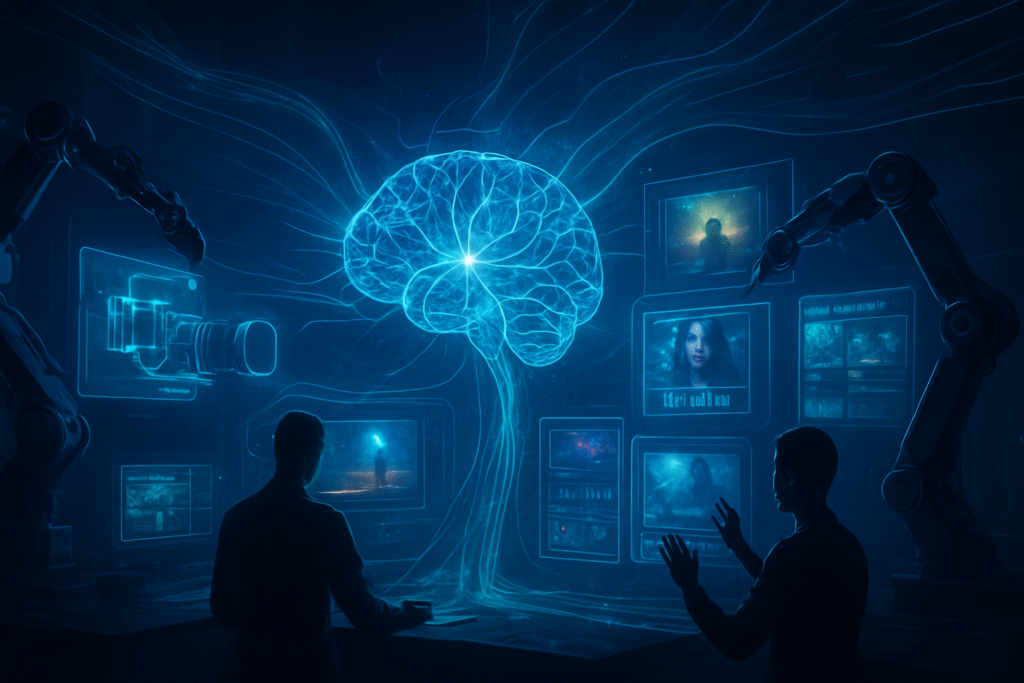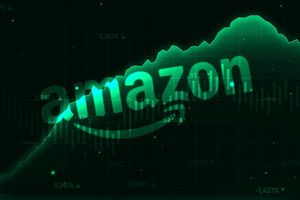
Netflix (NASDAQ: NFLX) is not just eyeing blockbuster moves in Hollywood; it's actively engineering them through a sophisticated integration of Artificial Intelligence (AI) and advanced media technologies. This strategic pivot is fundamentally reshaping how content is conceived, created, produced, and distributed, signaling a new era for the entertainment industry. The streaming giant's aggressive adoption of AI, from generative capabilities in VFX to an advanced production suite, aims to enhance efficiency, unlock new creative possibilities, and streamline global operations, setting a precedent that will reverberate across studios, tech giants, and creative communities worldwide.
The immediate significance of Netflix's technological foray is profound. It promises accelerated production timelines and significant cost efficiencies, potentially democratizing access to high-end filmmaking tools. However, these advancements also ignite heated debates around labor displacement, intellectual property rights, and the ethical implications of AI-generated content, forcing Hollywood to confront a future where human artistry and algorithmic innovation are inextricably linked.
The Technical Revolution Behind Netflix's Cinematic Ambitions
Netflix's technological innovations span the entire content lifecycle, leveraging AI and advanced media tech to push boundaries. At the forefront are its applications of generative AI in content creation and production. The company has established guidelines for its creative partners, delineating responsible and transparent AI use, viewing it as an empowering aid rather than a replacement for human creativity.
Specific technical applications are already yielding tangible results. In visual effects (VFX), generative AI was notably employed in the Argentine sci-fi series The Eternaut, where it generated a complex building collapse scene, drastically reducing costs and accelerating completion tenfold compared to traditional methods. Similarly, in Happy Gilmore 2, generative AI was used for character de-aging in an opening scene, showcasing its capability to manipulate visual elements with unprecedented precision. Beyond final effects, AI assists in pre-production visualization, as seen in Billionaires' Bunker, where it helped visualize wardrobe and set designs, streamlining the early stages of production. This approach differs significantly from previous methods that relied heavily on manual labor, extensive rendering farms, and time-consuming iterative processes, offering a faster, more cost-effective, and creatively flexible alternative.
Complementing its AI initiatives, Netflix has developed the Media Production Suite (MPS) within its Content Hub. This advanced suite aims to standardize and optimize global production by providing all Netflix shows worldwide with access to cutting-edge technology, regardless of location or budget. The MPS operates on a hybrid infrastructure, combining cloud-based and physically distributed capabilities connected via the Netflix Open Connect network to Amazon Web Services (AWS) (NASDAQ: AMZN). This robust setup efficiently handles vast volumes of camera and sound media, with global Content Hub Ingest Centers ensuring high-speed internet connectivity for rapid media uploads. The MPS further incorporates automation and tooling for automated footage ingest, remote editorial workstations, and automated VFX and conform pulls, along with media downloaders. This not only streamlines workflows and reduces human error but also enhances security and accessibility. By embracing open standards like ACES, AMF, ASC MHL, ASC FDL, and OTIO, Netflix facilitates collaboration across diverse markets, providing high-complexity workflows to productions that might otherwise lack access. This holistic approach to production technology represents a significant departure from fragmented, often bespoke production pipelines, offering a standardized, scalable, and globally accessible framework.
Reshaping the Competitive Landscape: Who Benefits and Who is Disrupted?
Netflix's aggressive embrace of AI and advanced media technologies will undoubtedly send ripples across the entertainment and technology sectors, creating clear beneficiaries and potential disruptions. Major AI labs and tech companies specializing in generative AI, cloud computing, and advanced media processing stand to benefit significantly. Companies like NVIDIA (NASDAQ: NVDA), with its powerful GPUs essential for AI model training and inference, and cloud providers such as Amazon Web Services (AWS) (NASDAQ: AMZN) and Google Cloud (NASDAQ: GOOGL), which provide the scalable infrastructure for Netflix's MPS and AI operations, will see increased demand for their services. Specialized AI startups offering solutions for VFX, de-aging, script analysis, and content personalization could also find new markets and partnership opportunities within Hollywood's evolving ecosystem.
The competitive implications for major studios and streaming platforms are profound. Netflix has explicitly acknowledged that if competitors gain an advantage through AI, it could negatively impact their own operations. This statement signals an impending technological arms race. Other streaming giants like Walt Disney Co. (NYSE: DIS), Warner Bros. Discovery (NASDAQ: WBD), and Apple Inc. (NASDAQ: AAPL) will likely accelerate their own AI research and development efforts to keep pace, investing heavily in similar tools for content creation, production, and distribution. This could lead to a significant divergence between studios that successfully integrate these technologies and those that lag, potentially disrupting existing market positioning. Smaller production houses and independent filmmakers, while potentially benefiting from democratized access to advanced tools via platforms like Netflix's MPS, might also struggle to compete with the sheer scale and efficiency of AI-powered productions from larger players without similar technological investments. The disruption extends to traditional post-production houses and VFX studios, which will need to adapt their business models and skill sets to integrate AI-driven workflows, or risk being outmaneuvered by in-house AI capabilities.
The Broader AI Landscape: Impacts, Concerns, and Milestones
Netflix's technological push fits squarely within the broader AI landscape's trend towards greater automation, personalization, and creative augmentation. It highlights the growing maturity of generative AI, moving from experimental applications to practical, cost-saving, and creativity-enhancing tools in a high-stakes industry. This development underscores the ongoing shift from AI as a mere data analysis tool to a powerful engine for content generation and workflow optimization across various creative domains.
However, this rapid integration comes with significant impacts and potential concerns. The most contentious issue remains labor displacement. Unions like the Screen Actors Guild–American Federation of Television and Radio Artists (SAG-AFTRA) and the Writers Guild of America (WGA) have voiced strong objections to AI's potential to diminish human jobs, dilute artistic integrity, and infringe on intellectual property rights. While Netflix's guidelines aim to mitigate these concerns by emphasizing responsible use, the underlying tension between technological progress and human employment in creative fields will persist. Ethical and legal challenges are also paramount. The widespread use of generative AI raises questions about deepfake misuse, inherent biases in AI algorithms influencing creative choices, and intellectual property theft, particularly when AI models are trained on copyrighted content without explicit consent. The legal framework for copyright protection of AI-generated material is still in its nascent stages, creating a complex environment for creators and studios alike.
Comparisons to previous AI milestones are inevitable. Just as AI transformed data analytics and recommendation engines, its current application in content creation marks a similar paradigm shift. It's akin to the introduction of computer-generated imagery (CGI) in the 1990s, which initially faced skepticism but ultimately became an indispensable tool. The difference now is the speed and autonomy of AI, which can not only generate visuals but also assist in narrative structures, character development, and even entire virtual worlds, pushing the boundaries far beyond traditional CGI.
The Horizon: Future Developments and Expert Predictions
The near-term future will likely see an accelerated integration of AI across all facets of content production. We can expect more sophisticated generative AI models capable of creating hyper-realistic visuals, complex narrative elements, and even entire virtual sets with minimal human input. This will lead to further automation in post-production, from intelligent editing assistants to AI-powered color grading and sound mixing. On the distribution front, AI will continue to refine personalization algorithms, potentially leading to dynamic content delivery where elements of a show or movie are customized in real-time for individual viewers, based on their preferences and viewing history.
Long-term developments could include fully AI-driven pre-visualization pipelines that generate complete storyboards and animatics from textual prompts, and AI systems capable of autonomously managing complex production schedules and resource allocation across multiple global projects. The emergence of new creative roles, such as "AI prompt engineers" or "AI-human collaboration specialists," is also on the horizon, focusing on guiding and refining AI outputs rather than performing tasks traditionally done by humans.
However, significant challenges need to be addressed. Regulatory frameworks must evolve to keep pace with technological advancements, particularly concerning intellectual property, ethical AI use, and data privacy. The industry will need to navigate the delicate balance between leveraging AI for efficiency and preserving the human element of storytelling. Experts predict that while AI will become an indispensable tool, the unique spark of human creativity, emotional intelligence, and nuanced storytelling will remain irreplaceable. The focus will shift from if AI will be used, to how it will be used to augment, rather than simply replace, human talent.
A New Era of Storytelling: Wrapping Up Netflix's AI Journey
Netflix's "blockbuster moves" in Hollywood, driven by AI and advanced media technologies, represent a pivotal moment in entertainment history. The key takeaways are clear: AI is no longer a peripheral tool but a central engine for content creation, production, and distribution, promising unprecedented efficiency and creative potential. The Media Production Suite and generative AI applications are setting new industry benchmarks, signaling a future where high-quality content can be produced faster and more cost-effectively on a global scale.
This development's significance in AI history lies in its demonstration of AI's practical, large-scale application in a complex creative industry, pushing the boundaries of what is possible. It underscores the rapid evolution of generative AI and its ability to move from theoretical concepts to tangible, impactful tools. The long-term impact will be a fundamentally transformed Hollywood, characterized by more dynamic production pipelines, hyper-personalized viewer experiences, and a continuous re-evaluation of human-AI collaboration in creative endeavors.
In the coming weeks and months, the industry will be watching closely for how other major studios respond to Netflix's technological lead, the outcomes of ongoing labor negotiations concerning AI, and the emergence of new ethical guidelines and regulatory frameworks. The journey ahead for AI in entertainment is complex, but one thing is certain: the future of storytelling will be deeply intertwined with the advancements unfolding today.
This content is intended for informational purposes only and represents analysis of current AI developments.
TokenRing AI delivers enterprise-grade solutions for multi-agent AI workflow orchestration, AI-powered development tools, and seamless remote collaboration platforms.
For more information, visit https://www.tokenring.ai/.




